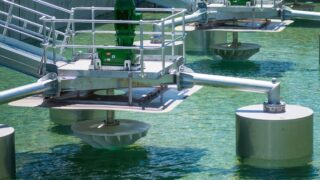How Can Digital Twin Wastewater Modeling Play An Important Role In WWTP Design?
Many mistakenly believe that digitalization in wastewater treatment is a new concept. In reality, digitalization has played an important role in the wastewater industry for many years. One example is the introduction of SCADA systems which began in the 1980s. Digitalization can be defined as the process of creating digital representations of physical assets and processes.
Overall, digitalization is the next big step for wastewater treatment plants (WWTPs). Digital twin wastewater modeling is a digitalization approach that offers many benefits for WWTP design, construction, and operation.
In this blog post, we will discuss digital twin wastewater modeling and its many benefits. We will also touch on some of the challenges faced by WWTP operators.
What is a Digital Twin?
A digital twin originated as a method for modeling complex and closed systems. It is a digital replica of a physical asset or process that can be used for various purposes such as monitoring, simulation, and analysis and is mostly used within industrial applications. It is updated in real-time by a two-way digital thread that links the digital and physical worlds while showcasing live features.
The digital twin concept has been around for over a decade but only recently has gained popularity in the wastewater industry where it first started on the ‘inside the fence’ or the ‘plant side’ of wastewater operations. This is mostly due to the plant side of the wastewater treatment plant being an enclosed area with a clearly defined scope of operations. Now, steps have been taken for digital twins to be used both inside and outside the fence of the treatment plant, where the physical and digital aspects of a wastewater treatment plant are linked – such as the physical assets and the control systems.
Transcend is at the forefront of digitalization within the wastewater industry. With the Transcend Design Generator, we have created water and wastewater digital twins for many years which have been used in several ways. From the digitalization of as-built drawings to digital prototypes that can be used for training and operator familiarization, digital twins created by Transcend offer many benefits.
Why Is a Wastewater Digital Twin Important?
There are many reasons digital twins are important, but here are the five main ones:
Geo-Information and Physical Data
A digital twin starts with a digital replica of the physical asset – sometimes linked with a GIS database. This includes all relevant geo-information and physical data and the location of different structures and equipment like pumps, tanks, and pipes. A digital twin also shares the positions of these assets in relation to other structures and how they are interconnected.
This is important because it provides an overview of the entire wastewater treatment plant and how each component works together. It also provides valuable information on the physical data of each asset, such as size, capacity, and weight. This is important for understanding the limits of each asset and how they may be impacted by different loads, flows, temperatures, and other treatment plant operations parameters.
With this knowledge, you can start merging digital data and real-world observations to get a better understanding of how a wastewater treatment plant is performing.
Directly Observing The Affected Environment
To understand the digital replica, you need data from the physical world. This can be in the form of direct observation or sensor data. Direct observation is when someone goes to the site and collects data manually. This is important for getting a ‘boots on the ground’ understanding of the environment and how it may be impacting the wastewater treatment plant.
Sensor data is collected by a variety of connected devices within the water or wastewater treatment plant. This data is then used to define the basis of the digital replica. Sensor data is important for understanding the real-time conditions of the wastewater treatment plant.
However, with the rapidly growing usage of industrial internet of things (IIOT) solutions, digital twins are now also being used for data collection. This is done by integrating digital devices such as sensors, meters, and cameras into the digital replica. Digital twins can predict what will happen to the physical world by using data from the digital world.
The Analytics Behind Digital Twin
The digital world runs on data and analytics. For the digital twin to be accurate, you need to have quality analytic systems to perform various analyses.
Many different types of analytics can be used for digital twins. The most common type is predictive analytics. Predictive analytics uses past data to understand trends and patterns. This information is then used to predict what will happen in the future.
Predictive analytics is important for digital twins because it allows you to understand how the digital world will impact the physical world. This is done by understanding how the digital replica will behave in different situations.
Utilizing Historical / Performance Data
Replicating the assets’ behavior is now possible with the help of digital twins and historical data. Stored static data can be used to understand how an asset has behaved in the past. This is important for digital twins because it allows you to understand the historical performance limits of each asset.
With the increase in the use of digital twins, there’s more of an effort to utilize dynamic data. For example, you can gather data on the asset’s usage, such as how often it’s used and for how long in real-time, or near real-time. This information is important for digital twins because it allows you to understand the asset’s performance at any given moment to better predict future performance.
Digitalization
Digitalization is the process of converting physical data into digital form. This is important for digital twins because it allows you to store and analyze data more effectively. A digital twin allows visualization and predictive modeling with the help of effective and accurate analytical data for data-driven decision-making.
Reactive vs Proactive WWTP Operations
Being proactive is far better than being reactive when it comes to wastewater plant operations. By being proactive, you can plan and execute accordingly such as automating tasks, conducting predictive maintenance, and improving your overall wastewater plant’s design when it comes to expansions, upgrades, and rehabilitations. Digital twins can help operations staff and engineers be more proactive with the data about how the treatment plant is operating, especially with the use of predictive analytics.
Embrace Digital Twin Wastewater Modeling With Transcend
Digital twin wastewater modeling is important for understanding how the digital replica will behave in different situations and impact the physical world. With this, all parties involved can better predict and plan for potential treatment challenges of the future, taking a more proactive approach to WWTP management.
The fundamental challenges of wastewater treatment plant design and operations can be overcome by embracing digital twin wastewater modeling with Transcend. The Transcend Design Generator offers an easy way to digitalize your wastewater plant so you can take a proactive approach to operations, capital planning, & expense management.







